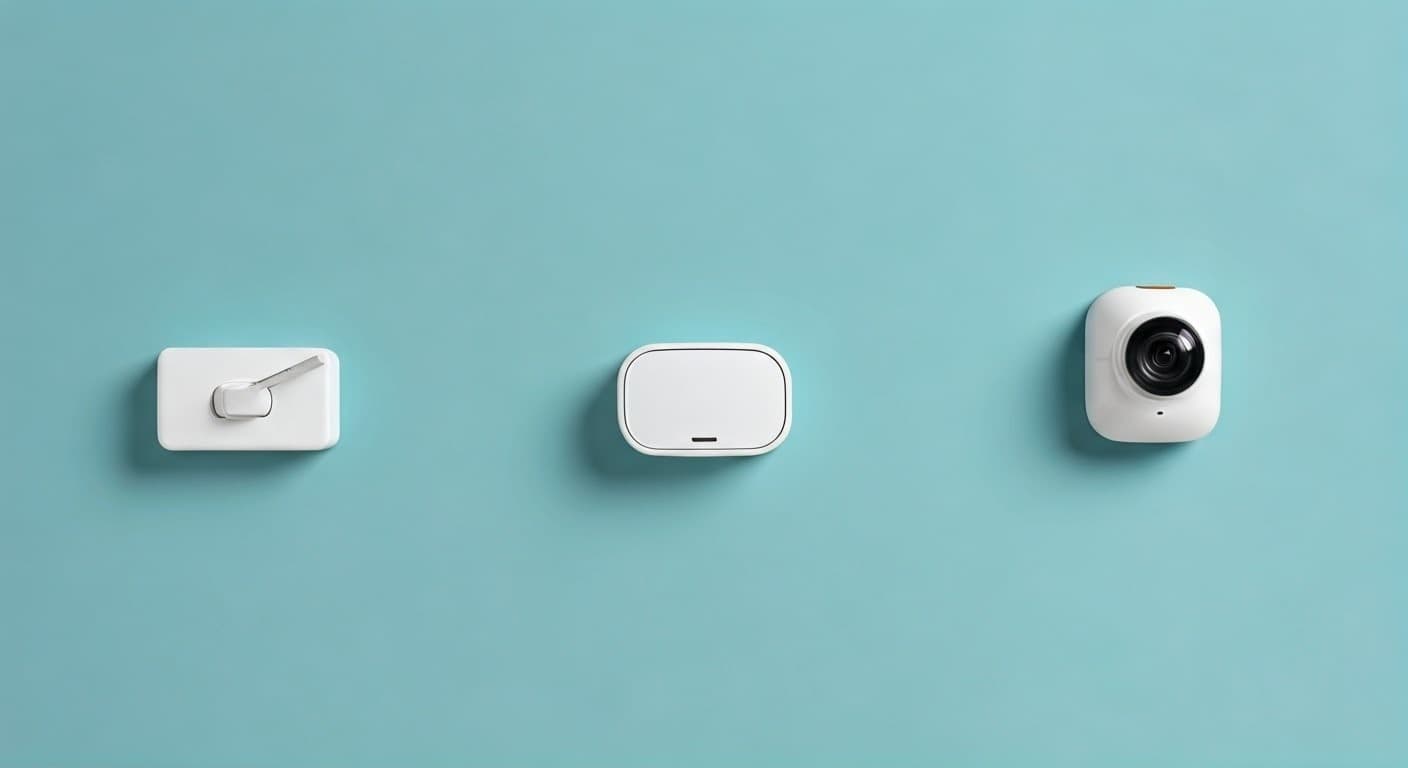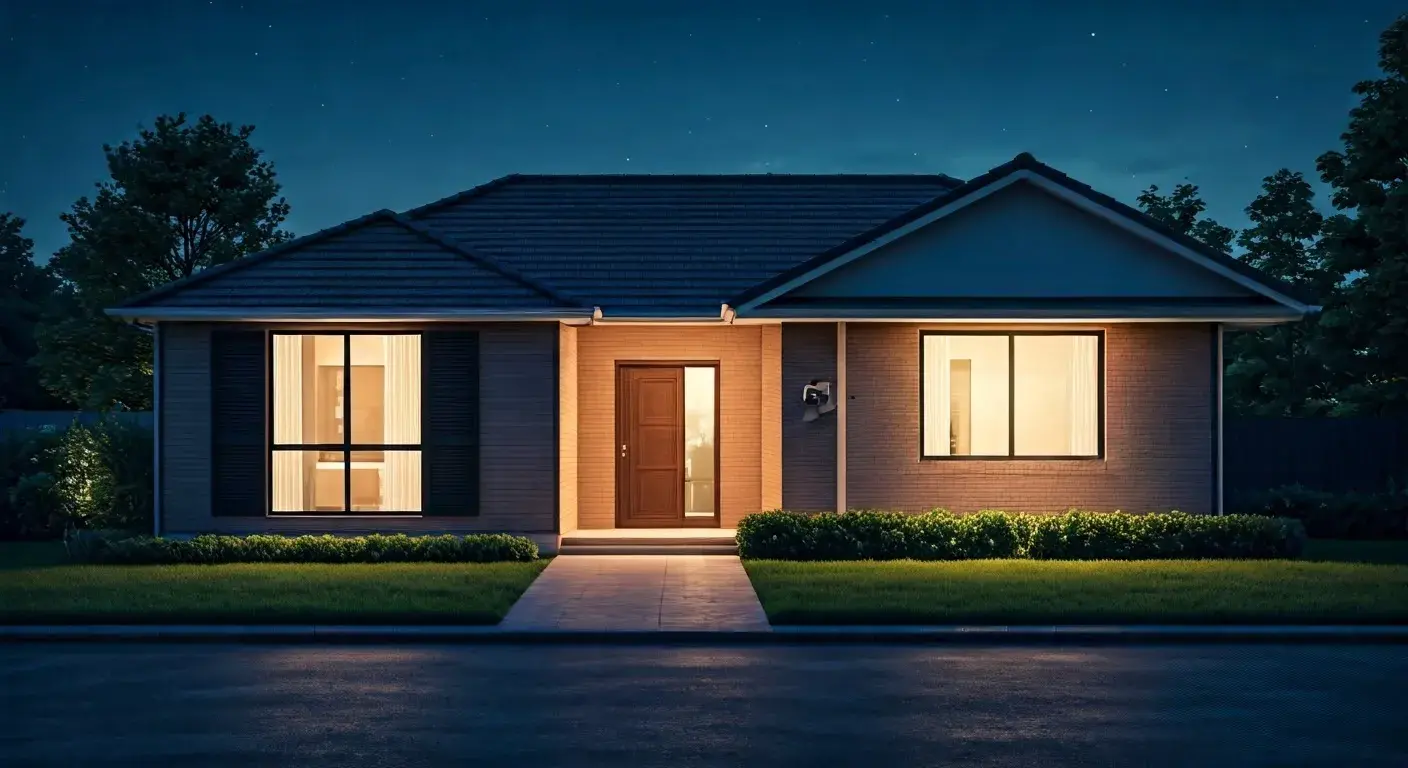Protecting your home is now easier thanks to DIY home security systems. These systems are advanced, affordable, and convenient compared to regular security setups. They work well with your smart home devices, like smart locks and outdoor cameras. DIY systems give you full control over your home’s safety. Plus, you can add professional monitoring to feel even more secure and enhance the level of protection. With this option, you can enjoy peace of mind knowing your home is safe all day and night.
Understanding DIY Home Security Systems
DIY home security systems and DIY alarm systems help homeowners manage their home security easily. You don't need professional installation to set them up. These systems usually include a main hub, called a base station, which connects wirelessly to other parts. These can be door and window sensors, motion detectors, security cameras, and more.
With user-friendly apps on your smartphone, you can check and control your security from anywhere. You can also personalize your system with extra components to meet your security needs. Whether you want to watch a back door, protect your garage, or have complete surveillance, DIY systems can fit various home layouts and security concerns.
The Basics of DIY Security Systems
At the heart of a DIY home security system is the base station. This is the main control panel that connects all parts of your security system. The base station links to your home Wi-Fi and allows communication with sensors and other devices. It also sounds the alarm if a sensor is triggered.
Today’s home security systems use wireless technology to keep everything connected. Battery-powered sensors are placed on doors, windows, or areas that detect motion. When triggered, they quickly send signals to the base station.
DIY systems are easy to set up and manage. This lets homeowners secure their properties without needing professional help. With simple smartphone apps, you can control your home security system completely. You can arm and disarm it and get real-time notifications too.
How DIY Systems Compare to Professional Installations
Choosing between a DIY home security system and professional installation means looking at the good and bad points of each choice. Professional installation is easy and is done by experts. However, it usually costs more at the start and comes with long contracts.
With DIY systems, you have more control over your security setup. You don’t have to sign contracts, which lets you change your system whenever you need to. You can add or take away parts as needed. You can also adjust sensor settings and manage your monitoring plan easily, which is often not available with professional setups.
One major benefit of DIY home security is how cost-effective it is. Since there are no installation fees or contracts, you can focus more on the features that matter most while keeping to your budget. There are many affordable DIY home security options on the market, making it easy for people to secure their homes.
Choosing the Right DIY Home Security System
Choosing the best DIY home security system is very important. Start by checking what your home security needs are. Think about the size of your home, how much protection you want, and how much money you can spend.
Look into whether you want professional monitoring for your system. Make sure to research trusted brands that offer reliable tools, easy-to-use systems, and good customer feedback. Also, look for features like smart home integration, different camera types, and environmental sensors. This will help you make the best choice for your home security.
Evaluating Your Home Security Needs
A careful look at your home security needs helps make sure your chosen system fits what you require. Think about these things:
- Size and layout of your home: If you have a bigger home, you may need more sensors and cameras to cover everything. Find the entry points, like windows and doors, that need monitoring.
- Desired level of security: Figure out how much protection you want. This could be basic intrusion detection or more advanced options like video surveillance, fire and CO alarms, and environmental monitoring.
- Budgetary considerations: Create a budget for your system. This should include the initial costs for equipment, any optional monitoring fees, and possible expenses for extra devices or features, like video storage.
Key Components of a DIY Security System
DIY security systems include different parts to help protect your home. Here are some key elements:
-
Control panel/Hub: This is the brain of the system. It connects and controls all the other devices.
-
Door and window sensors: These magnetic sensors can tell when doors or windows are open and trigger an alarm.
-
Motion detectors: They notice any movement in a specific area and alert you about possible intruders.
-
Security cameras: These cameras give live video feeds and recordings of your home for safety.
-
Alarm system: This makes a loud siren sound to scare off intruders and notify you and your neighbors about a break-in.
-
Environmental sensors: These sense smoke, carbon monoxide, floods, or high temperatures for your safety.
Top DIY Home Security Systems Reviewed
The market has many well-known DIY home security systems. Each system has its own strengths and weaknesses. To find the right system for your needs, you should look at things like how easy it is to use, what features it offers, and the price.
If you care about low cost, smart home integration, or great features, researching top-rated systems like SimpliSafe, Ring Alarm Kit, Abode iota, and Nest Secure that connect to your network router can help you make a smart choice.
SimpliSafe: A Comprehensive Solution
SimpliSafe is a simple and complete DIY home security system that also offers optional professional monitoring options. It is known for being reliable and easy to install. The best part is how easy it is to set up, which makes it a top choice for those who want a smooth experience.
You can choose optional professional monitoring service plans for added security using the SimpliSafe app. These plans come with cellular backup, so you stay protected even if the power goes out. The SimpliSafe app is the main tool for managing your system. It allows you to arm and disarm your system, get real-time alerts, and change settings to fit your needs.
SimpliSafe has a good selection of security tools. , including glass break sensors. However, remember that the monitoring plan does not come with video storage. Plus, it works with August Smart Locks, so you can lock and unlock your door from a distance. This makes your home even safer and easier to manage.
Ring Alarm Kit: Flexibility and Integration
The Ring Alarm Kit is well-known for its different types of cameras and doorbells. It gives you the ability to use many add-on accessories. You can easily connect it with Amazon Alexa using the Ring Alarm app. This allows you to control your system with simple voice commands. This makes it easy to use and very helpful.
You can also strengthen your security with optional professional monitoring plans for the Ring Alarm, which come with a monthly fee. These plans offer cellular backup, so you stay safe even if your internet goes down.
The wide variety of compatible devices, such as indoor and outdoor cameras and video doorbells, means you can customize the system to suit your needs. If you already use many Amazon Alexa products, the Ring Alarm Kit works very well with them.
Abode iota: Smart Home Compatibility
Abode iota is perfect for people who love smart homes. It works well with Apple HomeKit, Google Assistant, and Amazon Alexa. You can easily connect it to your current smart home devices. This allows you to control everything from one place and automate tasks.
The CUE automation engine in Adobe Iota focuses on making automation and customization easy. It helps you make unique setups by linking your security system with other smart home devices. For example, you can set your lights to turn on when they sense motion or create certain actions based on different modes of your system.
Even though Abode has strong features for smart home integration, the costs for professional monitoring and video storage can be higher than other options. Still, its high level of customization and wide compatibility with various smart home systems make it a great choice for tech-savvy homeowners.
Nest Secure: For Google Home Users
Deep integration with the Google Home ecosystem makes Nest Secure a great pick for users already using Google's products. The system connects easily with other Nest devices, like thermostats, cameras, and doorbells. This allows for central control through the Google Home app.
One of the best things about Nest Secure is how easy it is to use. Instead of traditional keypads, it uses special tags for arming and disarming. This makes it simpler to operate without needing to remember codes.
Even though Nest has a strong set of features and works well with other devices, it does not have local video storage. Footage is mainly saved on Google's cloud servers, which might come with a subscription fee. Still, its connection with other Google services and simple operation make it an appealing choice.
Installation Tips for DIY Security Systems
Installing a DIY security system is simple. This is possible due to clear instructions and easy-to-use designs. Planning how your system is set up helps with coverage and effectiveness.
Think about where your doors, windows, and possible entry points are. This helps you find the best spots for sensors, detectors, and cameras. Also, check the Wi-Fi signal strength and the nearest power outlets. This will ensure everything connects well and works efficiently.
Planning Your System Layout
Planning your system layout well helps improve its coverage and efficiency.
-
Identify entry points: First, find all possible entry points in your home. This includes doors, windows, and other spots like basements and attached garages.
-
Consider high-traffic zones: Next, look at busy areas in your home. This can be hallways, staircases, or living rooms. Placing motion sensors here can help you cover more ground.
-
Camera placement: If you are adding security cameras, think about their views and any blind spots. Place them wisely to watch entry points, valuable places, or weak spots around your home.
By mapping out the layout and thinking of these things, you can improve the security of your DIY system.
Do's and Don’ts of DIY Installation
Do:
-
Test your system: Check every part of the system. Make sure they work well with the base station.
-
Secure sensors properly: Use good glue or mounting tools to attach sensors to doors, windows, and walls firmly.
-
Keep devices clean: Clean sensors and cameras often. This helps them work well and reduces false alarms.
Don't:
-
Ignore battery life: Change batteries in sensors and detectors right away when the system shows low power. This helps avoid any disruptions in protection.
-
Install in unsuitable locations: Don't put motion sensors close to heat sources, air vents, or bright sunlight areas.
-
Disclose your security codes: Keep your security codes secret. Only share them with trusted family members or those who need access.
Integrating Smart Home Devices with Your Security System
Integrating your DIY security system with smart home devices makes your life easier and safer. When you connect your security system with other smart devices, you get a more connected and responsive home.
Using voice commands with your smart home also makes it simple to control everything. This adds more comfort to your daily life and boosts your security. Overall, combining compatible smart devices leads to better safety and a more comfortable living space.
Popular Smart Devices for Enhanced Security
Many smart devices can easily work with your DIY security system to boost safety:
-
Smart locks: You don't need traditional keys. They allow you to control access from anywhere. You can give temporary access to guests or service providers. You can also check when someone enters or leaves. These locks work with your security system to trigger actions like turning off the alarm when you unlock the door.
-
Video doorbells: These devices mix a doorbell with a camera for better security. You get alerts and live video when someone is at your door. You can talk to visitors from afar to stop package theft. They can also work with your security system to record events or turn on other security features.
-
Smart lighting: They help make your home look occupied, which raises security. You can set the lights to turn on and off at certain times or control them with a smartphone. They integrate with your security system to light up your home if someone moves nearby or if an alarm goes off, helping to scare off intruders.
Step-by-Step Guide to Integration
Integrating your smart devices with your security system can typically be achieved through these general steps:
-
Check compatibility: Ensure that your chosen devices are compatible with your DIY home security system. Check the manufacturer's website or app for a list of compatible devices and platforms.
-
Connect to Wi-Fi: Use your smart device's app to connect it to your home's Wi-Fi network. Follow the on-screen instructions and input your Wi-Fi credentials to establish a connection.
-
Pair devices: Access your security system's app and navigate to the integration or settings section. Look for an option to add new devices or connect to smart home platforms.
Maximizing Your DIY System’s Efficiency
To keep your DIY system working well, it is important to do regular maintenance. Check the parts of your system often. Clean the sensors and test if they are working properly. Change the batteries right away if they need it. This will help prevent any breaks in protection.
If you have technical problems, fix them quickly to keep your system going. You can look at the user manual for help or reach out to customer service for support.
Routine Maintenance Tips
Proactive maintenance helps your DIY system stay reliable:
-
Battery checks: Check the battery levels of all battery-powered sensors and detectors regularly. Follow the manufacturer's guidelines for when to replace the batteries.
-
Sensor cleaning: Dust and dirt can mess up the function of sensors. This could cause false alarms or missed detections. Use a soft, dry cloth to clean your sensors.
-
Signal testing: Test the wireless signal strength between sensors and the base station from time to time. This ensures that all parts are communicating well.
Troubleshooting Common Issues
DIY security systems are made to be easy for users, but sometimes problems can happen:
-
False Alarms: If you get many false alarms, it might be due to a sensor that is not aligned, a low battery, or settings that are too sensitive. Check how the sensors are placed, change the batteries, or adjust the sensitivity settings in the app.
-
System Offline: When your system is offline, check your internet connection and make sure the base station is on. You might want a system that has battery backup and cellular backup to keep it working during outages.
-
Device Connectivity: If you cannot connect a new device, there might be interference with the signal. Try moving the device closer to the base station or getting rid of things that block the signal.
If these steps do not fix the issues, you can contact the manufacturer's customer service for help.
Enhancing Your Security with Additional Features
Make your security system fit your specific needs by adding new features. Putting outdoor security cameras in key spots increases your watch over the area. Think about having night vision and motion detection for the best results. Connect them with your security system to get the most protection.
Adding motion sensors boosts your perimeter security. Put them in places like hallways, stairwells, or driveways to alert you early. These sensors can spot and report any suspicious actions to your control panel, which helps keep potential intruders away.
The Role of Surveillance Cameras
Surveillance cameras are very important for preventing crime and providing proof when something happens. Outdoor security cameras should be placed carefully to watch entry points, driveways, and weak spots. They can record any suspicious behavior.
These cameras not only help stop crime but also provide useful evidence. If a break-in or vandalism occurs, the video can help the police investigate. When choosing the right cameras, look for things like video quality, night vision, and how to store the videos.
Many people choose cloud storage subscriptions, which keep recorded video safe away from home. Some systems, however, use local video storage with SD cards or network video recorders (NVRs). This gives you better control over your recorded videos.
Incorporating Motion Sensors and Smart Locks
Motion sensors work like an invisible shield. They see any movement in their area and set off an alarm. Placing these sensors where many people go or near doors makes your home safer. It also gives you a warning before any trouble starts.
Smart locks are great for easy entry and improved security. Replacing regular locks with smart locks lets you lock and unlock doors from anywhere. You can let family members or trusted friends in without a key. Features like tamper alerts and activity logs help you keep an eye on any possible break-ins.
By connecting smart locks to your DIY security system, you can automate and manage it from afar. For example, your system can turn off the alarm when you use your smart lock. You can also get alerts whenever the door opens or closes.
The Future of Home Security
Advancements in smart home technology are changing how we think about home security. DIY security systems lead this change. New features and integrations will make homes safer and give homeowners more peace of mind.
As technology continues to grow, we can expect smarter features, easy connections, and security measures that act quickly to possible threats. The future looks bright for a safer and more connected home.
Emerging Trends in DIY Security
The DIY security scene keeps changing, and there are some important trends to notice:
-
Artificial Intelligence: AI systems are becoming common. They offer features like facial recognition, object detection, and finding unusual activities.
-
Integration with Voice Assistants: We see more integration of voice assistants like Amazon Alexa and Google Assistant. This allows users to control their security systems simply by using voice commands, which makes it easy and user-friendly.
-
Cybersecurity Enhancements: With more smart home devices connecting together, companies focus a lot on cybersecurity. They want to protect users from hacking and keep data safe.
Innovations on the Horizon
The future of home security looks thrilling. These advancements will create better, more personal, and active security solutions:
-
Predictive Security: Think of a system that checks data from sources like sensors, security cameras, and local crime reports. With AI help, these systems can spot security risks and alert homeowners.
-
Personalized Security Profiles: Future systems may let you make personal security profiles for everyone in the house. You could set up custom alerts, permissions, and actions based on each person's daily habits and choices.
-
Enhanced Environmental Monitoring: Home security will go beyond just preventing break-ins and fires. Future systems may have sensors that watch air quality, humidity, and other factors that help create a safer and healthier home.
Conclusion
In conclusion, DIY home security systems are convenient and affordable while still keeping you safe. By knowing what you need for home security, you can choose the right parts for a system that is just right for you. Options like SimpliSafe, Ring Alarm Kit, Abode iota, and Nest Secure are highly rated and can work well with smart home devices for extra safety and ease. Regular care, fixing problems, and using features like surveillance cameras and motion sensors will improve your DIY system’s performance. Keep up with new trends and ideas in DIY security to protect your home for years to come. If you want to keep your home safe, start by looking at your needs and picking the best DIY security system for your peace of mind.






